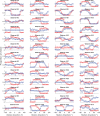Idiosyncratic preferences in transparent motion and binocular rivalry are dissociable
- PMID: 33156337
- PMCID: PMC7671871
- DOI: 10.1167/jov.20.12.3
Idiosyncratic preferences in transparent motion and binocular rivalry are dissociable
Abstract
Previous studies revealed that there are idiosyncratic preferences to perceive certain motion directions in front during motion transparency depth rivalry (Mamassian & Wallace, 2010; Schütz, 2014). Meanwhile, other studies reported idiosyncratic preferences in binocular rivalry during the onset stage (Carter & Cavanagh, 2007; Stanley, Carter, & Forte, 2011). Here we investigated the relationship of idiosyncratic preferences in transparent motion and binocular rivalry. We presented two dot clouds that were moving in opposite directions. In the transparent motion condition, both dot clouds were presented to both eyes and participants had to report the dot cloud they perceived in front. In the binocular rivalry condition, the dot clouds were presented to different eyes and participants had to report the dominant dot cloud. There were strong idiosyncratic directional preferences in transparent motion and rather weak directional preferences in binocular rivalry. In general, binocular rivalry was dominated by biases in contrast polarity, whereas transparent motion was dominated by biases in motion direction. A circular correlation analysis showed no correlation between directional preferences in transparent motion and binocular rivalry. These findings show that idiosyncratic preferences in a visual feature can be dissociated at different stages of processing.
Figures





References
MeSH terms
LinkOut - more resources
Full Text Sources

